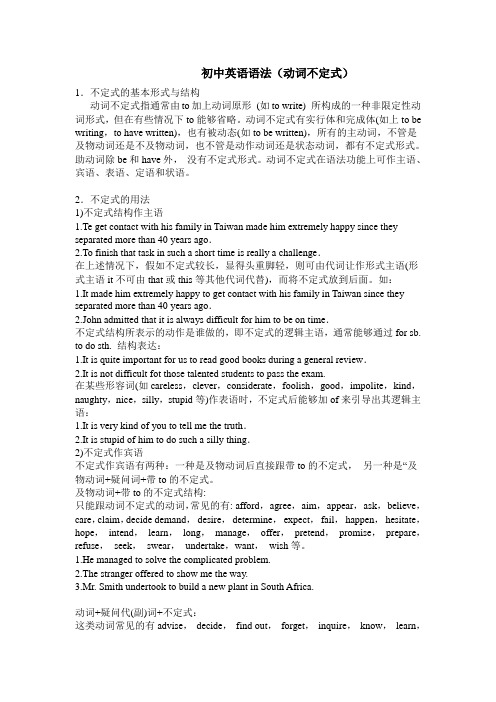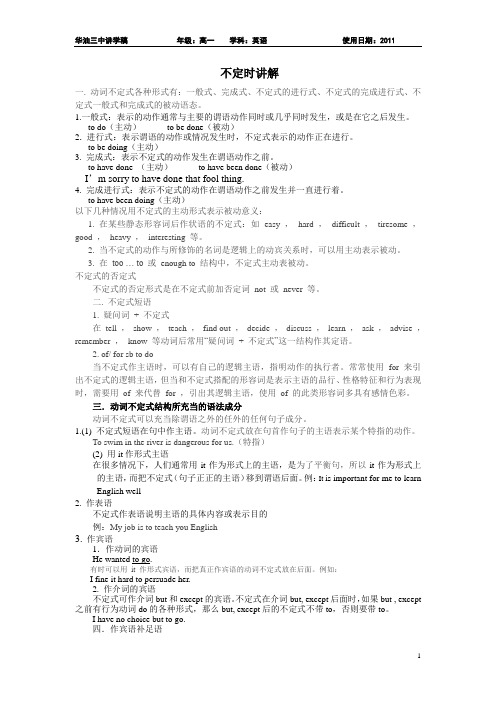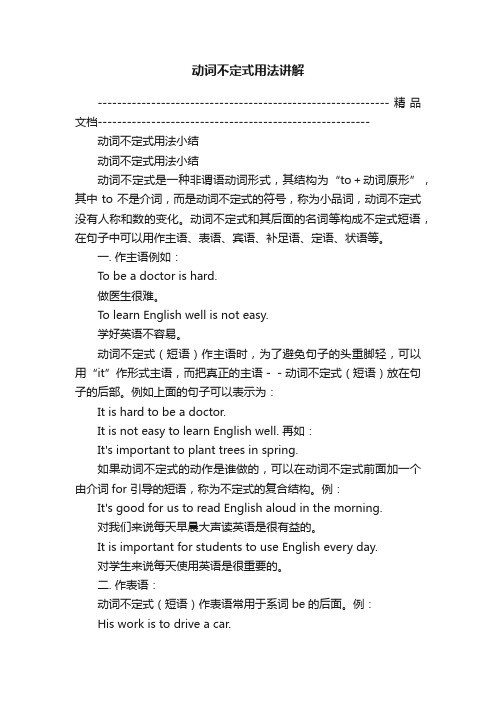动词不定式讲解
动词不定式讲解

动词不定式不定式具有动词的性质,在句中有自己的宾语,并可被状语所修饰。
同时还具有名词、形容词、和副词的性质,在句中可作主语、表语、宾语、宾语补足语、定语、状语等成分。
一作主语1不定式可做主语To hesitate means failure犹豫不决就意味着失败To become a good teacher was my hope.2经常把it放在句首做形式主语,而把真正主语(不定式)放在句末It is very difficult to solve this problem.二作表语不定式可做表语,说明或解释主语的内容Our purpose is to finish the job in the three weeks.三不定式作宾语The children refused to listen to me1有些动词常跟不定式做宾语:agree,decline,refuse,offer,promise,choose,decide,determine,attempt,intend,manage,fail,ask,hope,want,expect,long,wish,tend,desire,seek,claim,pl an,prepare,learn,volunteer,pretend,dare,afford,arrange,beg,demand,happen,bear,hesitate,prefer,strive,threaten等2如果动词后有不定式做宾语而后又跟宾补,这时要用it做形式宾语,而将不定式放到补语后I find it difficult to solve this problem.四不定式作宾补1有些动词后常跟不定式做宾补My parents won’t allow me to stay out late这些动词有:advise,command,force,allow,encourage,instruct,ask,entitle,beg,expect,invite,compel,forbid,like,mean,tempt,oblige,remind,urge,order,want,permi t,wish等2在某些动词短语如rely on,depend on ,wait for等后面,也可跟不定式做补语You can’t depend on him to come punctually.3在think,consider,believe ,find,feel,know,declare,guess,prove,suppose,imagine,judge等词后面,常跟to be+adj/n,但to be常常省略She believes him( to be )honest4hope,demand,suggest等动词后面不可接动词不定式做宾补He hoped his sister to lend him a hand (F)He hoped that his sister would lend him a hand (T)五不定式做定语1不定式用在the first,the second,the last,the next,the only,等短语后面以及形容词最高级修饰的名词后做定语He was the first to arrive2 不定式做定语与被修饰的中心词之间常表现为动宾关系,如果不定式是不及物动词或不定式本身已有宾语,其后应该有必要的介词。
动词不定式讲解,专项练习及答案

初中英语语法(动词不定式)1.不定式的基本形式与结构动词不定式指通常由to加上动词原形(如to write) 所构成的一种非限定性动词形式,但在有些情况下to能够省略。
动词不定式有实行体和完成体(如上to be writing,to have written),也有被动态(如to be written),所有的主动词,不管是及物动词还是不及物动词,也不管是动作动词还是状态动词,都有不定式形式。
助动词除be和have外,没有不定式形式。
动词不定式在语法功能上可作主语、宾语、表语、定语和状语。
2.不定式的用法1)不定式结构作主语1.Te get contact with his family in Taiwan made him extremely happy since they separated more than 40 years ago.2.To finish that task in such a short time is really a challenge.在上述情况下,假如不定式较长,显得头重脚轻,则可由代词让作形式主语(形式主语it不可由that或this等其他代词代替),而将不定式放到后面。
如:1.It made him extremely happy to get contact with his family in Taiwan since they separated more than 40 years ago.2.John admitted that it is always difficult for him to be on time.不定式结构所表示的动作是谁做的,即不定式的逻辑主语,通常能够通过for sb. to do sth. 结构表达:1.It is quite important for us to read good books during a general review.2.It is not difficult fot those talented students to pass the exam.在某些形容词(如careless,clever,considerate,foolish,good,impolite,kind,naughty,nice,silly,stupid等)作表语时,不定式后能够加of来引导出其逻辑主语:1.It is very kind of you to tell me the truth.2.It is stupid of him to do such a silly thing.2)不定式作宾语不定式作宾语有两种:一种是及物动词后直接跟带to的不定式,另一种是“及物动词+疑问词+带to的不定式。
动词不定式讲解

prefer等。
巧记动词不定式作宾语歌诀:
•
• • • • • • •
想要拒绝莫忘记 (want, refuse, forget) 需要努力就学习 (need, try, learn) 喜欢帮助加同意 (like help agree ) 希望决定后开始 (hope, decide, begin, start)
get to sleep. I feel it easy to recite the text
点击规律: 这些动词后面除接不定式外, 还可以接动名词, 意 思区别不大。
提示板:like
doing指经常性动作,而like to do指一次性的
动作。 I like swimming,but I don‘t like to swim now. 我喜欢游泳, 但我现在不想游。 begin\start to do sth begin\start doing sth love \hate to do sth love \hate doing sth
• He wants to be a singer
• 14. want doing
需要;该
• The tea table wants washing 茶几需要清洗了
• 15. need \require to do sth 需要做某事
• We need \require to do a lot of work
• 7. mean to do sth 打算做某事 • We mean to travel abroad next year
• 我们明年打算去国外旅行
• 8. mean doing sth 意味着
• It means waiting for him another hour
动词不定式的完整讲解

动词不定式1、不定式的时态和语态:一般式:完成式:进行式:不定式的一般式表示的动作与谓语动词表示的动作一般没有时间先后顺序。
不定式的完成式表示额动作一般发生在谓语动词之前,强调动作的先后顺序。
不定式的进行式表示的动作一般与谓语动词同时进行。
翻译下列句子:1)I hope to finish reading the book again.2) You appear to have travelled quite a lot.3) It’s nice to be sitting here with you.4) I am v ery happy to be praised.5) It is impossible for him to be appointed.2、不定式的句法功能1)作主语To succeed calls for hard work.(不定式在句中作主语相当于名词或代词。
)It seemed selfish of him not to give them anything. (不定式作主语往往用形式主语it 代替)It’s difficult for us to finish the work in a week.2)作宾语不定式一般作动词的宾语,不直接作介词的宾语,但“疑问词+不定式”结构可以作介词的宾语。
如:Y our father has at last decided to quit smoking.Talk with friends about where to shop.只接to do 作宾语的常见动词有:afford, agree, arrange, ask, care, choose, decide, demand, determine, expect, help, hope, plan, hesitate, long, manage, offer, prepare, refuse, pretend, promise, want, intend ,prefer3)作表语,可以表示主语的具体内容,目的。
动词不定式用法讲解

动词不定式用法讲解1、构成及特征2、动词不定式(infinitive)是动词的一种非限定形式,即非谓语动词形式,它有两种形式:一种是“to+动词原形”构成(to-infinitive);另一种是不带to的不定式,即动词原形(bare-infinitive)。
所有行为动词都有不定式形式,其否定式是在不定式前加not。
动词不定式(或不定式短语)没有人称和数的变化,在句子中不能作谓语。
动词不定式仍保留有动词的特点:3、(1)可以有时式和语态的变化,也可以有自己的宾语或状语,它们一起构成了不定式短语。
4、Hetriedtoworkouttheprobleminfiveminutes.他试图在五分钟之内算出这道题。
(带宾语和状语)5、Thefactorytobebuiltherenextyearisacarfactory.明年在这里建的工厂是一家汽车制造厂。
(有语态的变化)6、(2)动词不定式还具有名词、形容词和副词的特征,在句中可以作主语、宾语、表语、补语、定语、状语等成分。
7、HewantstostudyEnglish.他想学英语。
(tostudyEnglish在句中作want的宾语,而tostudy又有自己的宾语English,tostudy和English一起构成了不定式短语。
)8、Nevertooffendanyoneishisprinciple.不得罪人是他的原则。
(不定式作主语)9、注意:不定式在许多场合具有情态意义。
作主语时,相当于一个带有情态动词的主语从句;作宾语时,相当于一个带有情态动词的宾语从句;作定语时,相当于一个带有情态动词的定语从句;作目的状语时,相当于sothat或inorderthat引导的目的状语从句。
10、Itisrightforhertosayso.(=Itisrightthatsheshouldsayso.)她这样说是对的。
11、Hehasalotofworktodo.(=…thatheshoulddo)他有很多工作要做。
非谓语动词动词不定式讲解

• •
To learn an art is very hard. 学习一门艺术很难。 To master a foreign language calls for a great deal of memory work. 掌握一门外语需要大量的记忆。
ஐ 注 :常用it作形式主语,将to do位于之后, 作真正主语,使句子保持平衡。
• It is necessary for you to get there on time.
按时到达那里是很必要的。 • It is impolite of you to speak to the teacห้องสมุดไป่ตู้er like that. • =You are impolite to speak to the teacher like that. 你那样对老师说话是很不礼貌的。
• It’s kind of you to help me.
2、作表语
不定式作表语表示主语的“职业、职责或性质”等,从时间概念上说含有将来 意义。 • Our duty is to help the young children to grow better. 我们的职责就是帮助孩子们更好的成长。
动词不定式
一、 动词不定式的基本构成
由不定式符号to加动词原形构成。其否定形式由not+不定
式构成。
肯定式:to do sth.
否定式:not to do sth.
被动式:to be done 完成式:to have done
二、动词不定式的句法功能
1.作主语
不定式在句子中作主语,相当于名词或代词的作用。
职责。
• It is a great enjoyment to spend our holiday in the mountains. 在山上度过我们的假日真是一个莫大的享受。
动词不定式讲解不定时的讲解

不定时讲解一. 动词不定式各种形式有:一般式、完成式、不定式的进行式、不定式的完成进行式、不定式一般式和完成式的被动语态。
1.一般式:表示的动作通常与主要的谓语动作同时或几乎同时发生,或是在它之后发生。
to do(主动)to be done(被动)2.进行式:表示谓语的动作或情况发生时,不定式表示的动作正在进行。
to be doing(主动)3. 完成式:表示不定式的动作发生在谓语动作之前。
to have done (主动)to have been done(被动)I’m sorry to have done that fool thing.4. 完成进行式:表示不定式的动作在谓语动作之前发生并一直进行着。
to have been doing(主动)以下几种情况用不定式的主动形式表示被动意义:1. 在某些静态形容词后作状语的不定式:如easy ,hard ,difficult ,tiresome ,good ,heavy ,interesting 等。
2. 当不定式的动作与所修饰的名词是逻辑上的动宾关系时,可以用主动表示被动。
3. 在too … to 或enough to 结构中,不定式主动表被动。
不定式的否定式不定式的否定形式是在不定式前加否定词not 或never 等。
二. 不定式短语1. 疑问词+ 不定式在tell ,show ,teach ,find out ,decide ,discuss ,learn ,ask ,advise ,remember ,know 等动词后常用“疑问词+ 不定式”这一结构作其定语。
2. of/ for sb to do当不定式作主语时,可以有自己的逻辑主语,指明动作的执行者。
常常使用for 来引出不定式的逻辑主语,但当和不定式搭配的形容词是表示主语的品行、性格特征和行为表现时,需要用of 来代替for ,引出其逻辑主语,使用of 的此类形容词多具有感情色彩。
动词不定式用法讲解

动词不定式用法讲解------------------------------------------------------------精品文档-------------------------------------------------------- 动词不定式用法小结动词不定式用法小结动词不定式是一种非谓语动词形式,其结构为“to+动词原形”,其中to不是介词,而是动词不定式的符号,称为小品词,动词不定式没有人称和数的变化。
动词不定式和其后面的名词等构成不定式短语,在句子中可以用作主语、表语、宾语、补足语、定语、状语等。
一. 作主语例如:To be a doctor is hard.做医生很难。
To learn English well is not easy.学好英语不容易。
动词不定式(短语)作主语时,为了避免句子的头重脚轻,可以用“it”作形式主语,而把真正的主语--动词不定式(短语)放在句子的后部。
例如上面的句子可以表示为:It is hard to be a doctor.It is not easy to learn English well. 再如:It's important to plant trees in spring.如果动词不定式的动作是谁做的,可以在动词不定式前面加一个由介词for 引导的短语,称为不定式的复合结构。
例:It's good for us to read English aloud in the morning.对我们来说每天早晨大声读英语是很有益的。
It is important for students to use English every day.对学生来说每天使用英语是很重要的。
二. 作表语:动词不定式(短语)作表语常用于系词be的后面。
例:His work is to drive a car.他的工作是开车。
My job is to feed animals.我的工作是饲养动物。
- 1、下载文档前请自行甄别文档内容的完整性,平台不提供额外的编辑、内容补充、找答案等附加服务。
- 2、"仅部分预览"的文档,不可在线预览部分如存在完整性等问题,可反馈申请退款(可完整预览的文档不适用该条件!)。
- 3、如文档侵犯您的权益,请联系客服反馈,我们会尽快为您处理(人工客服工作时间:9:00-18:30)。
动词不定式的用法概念:动词不定式由to+动词原形构成。
这里的to是不定式标志,没有词义。
不定式具有名词、形容词或副词的某些语法功能,又有动词的时态和语态的特点及作用。
可以做主语、宾语、宾语补足语、表语、定语、状语。
一、作主语动词不定式作主语时,句子的谓语动词常用单数,其位置有以下两种:(1)把不定式置于句首。
如:To get there by bike will take us half an hour.(2)用it作形式主语,把真正的主语不定式置于句后,常用于下列句式中。
如:①It+be+名词+to doIt's our duty to take good care of the old.②It takes sb+some time+to doHow long did it take you to finish the work③It+be+形容词+for sb+to doIt is difficult for us to finish writing the composition in a quarter of an hour.在句型③中,常用表示客观情况的形容词,如:easy, difficult, hard, important, possible, impossible, comfortable, necessary, better;the first, the next, the last, the best, too much, too little, not enough④It+be+形容词+of sb+to doIt is stupid of you to write down everything the teacher says.在句型④中,常用careless,clever,good,foolish,honest,kind,lazy,nice,right,silly,stupid,wise rude, clever, foolish, thoughtful, thoughtless(欠考虑的;不考虑的), brave, considerate(考虑周到的), selfish(自私的)等表示赞扬或批评的词。
在不定式前的sb,可看作其逻辑主语。
这一句式有时相当于Sb is+形容词+to do句式,如:It's kind of you to help me with my English.=You are kind to help me with my English.⑤It seems(appears)+形容词+to doIt seemed impossible to save money.It seemed selfish of him not to give them anything. 他不给他们任何东西,这显得太自私了。
注意:1) 其他系动词如,look,appear等也可用于此句型2) 不定式作为句子主语时,动词用单数形式。
3) 当不定式作主语的句子中又有一个不定式作表语时,不能用It is… to…的句型对应性:To see is to believe. 百闻不如一见。
二、作宾语1) 以下动词后,只能跟不定式作宾语afford (付得起),agree(同意),aim(力求做到), appear(显得),arrange(安排),ask(要求),attempt (试图),care(想要),choose(决定),claim(声称),condescend (屈尊),consent(准许),decide(决定),demand(要求),determine(决心),endeavor (竭力),expect(期待),fail(未履行),help(帮助),hesitate(犹豫),hope(希望),learn(学会),manage(设法),neglect(疏忽),offer(主动提出),plan(计划),prepare (准备),pretend(假装),proceed(接着做),promise(答应),prove(证明),refuse (拒绝),resolve(解决),seem(觉得好像),swear(发誓),tend(往往会),threaten (威胁),undertake(承诺),volunteer(自愿做),vow(发誓),want(想要),wish(希望)举例:The driver failed to see the other car in time.司机没能及时看见另一辆车。
I happen to know the answer to your question.我碰巧知道你那道问题的答案。
2)动词+疑问词+ 不定式decide, know, consider forget, learn, remember, show, understand, see, wonder, hear, find out, explain, tellPlease show us how to do that. 请演示给我们如何去做。
There are so many kinds of tape-recorders on sale that I can't make up my mind which to buy.有这么多的录音机,我都拿不定主意买哪一种。
注意:疑问词带不定式在句中作主语时,谓语动词用单数。
The question is how to put it into practice.问题是怎样把它付诸实施。
3)当复合宾语中的宾语是不定式时,先用形式宾语it代替不定式,把不定式置于补语之后,即:主语+动词+it+补语+to do句式。
如:We think it quite important for us to learn a foreign language well.He feels it his duty to help the poor.I find it difficult to learn English well.三、作补语1) 动词+宾语+不定式(to do)advise allow believe cause challenge compel(强迫, 使不得不)declare encourage forbid force find hire induce(引诱, 劝导) instruct(命令, 指示)invite like order permit persuade remind request require select send suppose tell train urge(催促,鼓励)例句:a. Father will not allow us to play on the street.父亲不让我们在街上玩耍。
b. We believe him to be guilty.我们相信他是有罪的。
find 的特殊用法:find 后可用分词做宾补,或先加形式宾语,再加形容词,最后加带to 的动词不定式。
find 后也可带一个从句。
此类动词还有get,have。
I found him lying on the ground.I found it important to learn.I found that to learn English is important.典型例题:The next morning she found the man ___ in bed,dead.A. lyingB. lieC. layD. laying答案:A. find的宾语后面,用分词或分词短语,起宾语补足语作用。
现在分词表达主动,也表达正在进行,过去分词表达被动。
lie: 躺过去式 lay,过去分词 lain , 现在分词 lying;lie: 说谎过去式 lied,过去分词 lied , 现在分词 lying;lay:安放过去式 laid,过去分词 laid, 现在分词 laying;2) to + be 的不定式结构,作补语的动词。
Acknowledge ?承认, 供认, believe, consider, think, declare(声称),discover, fancy(设想), feel,find, guess, judge, imagine, know, prove, see(理解), show, suppose, take(以为), understandWe consider Tom to be one of the best students in our class.我们认为汤姆是班上最好的学生之一。
3) to be +形容词Seem, appear, be said, be supposed, be believed, be thought, be known, be reported, hope, wish, desire, want, plan, expect, mean…The book is believed to be uninteresting.It is believed that…人们认为这本书没什么意思。
有些动词需用as 短语做补语,如regard, think believe, take, consider.We regard Tom as our best teacher. 我们认为汤姆是我们最好的老师。
Mary took him as her father . 玛丽把他当作自己的父亲。
四、作表语不定式作表语表示具体动作或将来动作;动名词作表语表示抽象的一般行为。
①To be kind to the enemy is to be cruel to the people.②My chief purpose is to point out the difficulties of the matter.③What I would suggest is to put off the meeting.当主语和表语都是不定式时,其含义一是条件,一是结果(例①)。
当主语是aim,duty,hope,idea,mista ke,plan,purpose,suggestion等为中心词的名词词组(例②)时,或以what引导的名词性分句(例③),不定式说明主语的内容。
④Our work is serving the people.⑤What he likes is taking a walk after supper.⑥The story told by Mr Wang is interesting.④⑤句动名词作表语,与主语部分可以转换,如Serving the people is our work,而⑥句中是现在分词作表语,说明主语的性质、状态,现在分词具有形容词的各种特征,另外,动名词作表语还应与进行时态区别开来。
